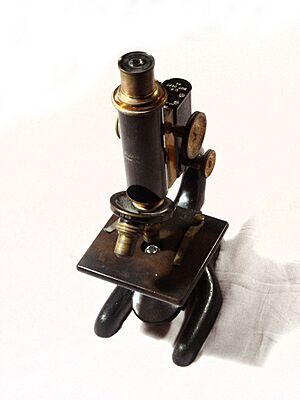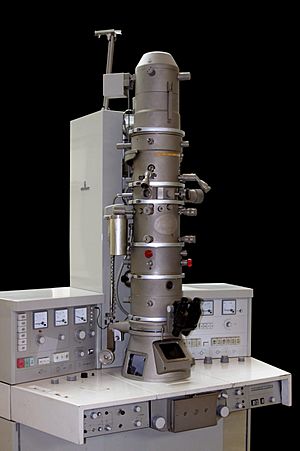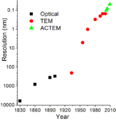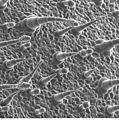Microscope facts for kids

A microscope is a special tool that makes very small things look much bigger. This helps people see tiny objects that are usually invisible to the eye. Many people use microscopes in their jobs, like doctors and scientists. Students in science classes, especially biology, also use them to study small living things.
The first microscopes were quite simple. They had only one lens and are called simple microscopes. Later, compound microscopes were invented. These have at least two lenses. In a compound microscope, the lens you look through is called the eyepiece. The lens closer to the object you are viewing is called the objective. These lenses work together to make things much larger. For example, if your eyepiece makes things 10 times bigger and your objective makes them 40 times bigger, the total magnification is 400 times! Microscopes can make objects appear up to 1000 times larger. This is much more powerful than a magnifying glass, which is a type of simple microscope.
Contents
Different Kinds of Microscopes
There are several types of microscopes, each used for different purposes.
Light Microscopes
The most common type is the compound light microscope. With this microscope, light shines through the object you want to see. The light then passes through two lenses, making the image much bigger. This allows you to see details of cells or tiny organisms.
Electron Microscopes
Another common type is the electron microscope. These microscopes use beams of electrons instead of light to see tiny things.
- Transmission electron microscopes (TEMs) shoot electron beams through the object. This creates an image that is then shown on a TV screen.
- Scanning electron microscopes (SEMs) also use electrons. They scan a single electron beam across the object. When the electrons hit the object, they create other signals, like X-rays. These signals are then used to create a magnified image on a screen.
- Scanning tunneling microscopes were invented in 1984. They can even see individual atoms on a surface!
Fluorescence Microscopes
A fluorescence microscope is a special kind of light microscope. It uses a special type of light to make certain parts of an object glow, or "fluoresce." This helps scientists see specific structures inside cells. In 2014, three scientists, Eric Betzig, William Moerner, and Stefan Hell, won the Nobel Prize in Chemistry. They were honored for making fluorescence microscopy even better, allowing us to see things at a super tiny, nano-level!
Images for kids
-
18th-century microscopes from the Musée des Arts et Métiers, Paris
-
Electron microscope built by Ernst Ruska in 1933
See also
 In Spanish: Microscopio para niños
In Spanish: Microscopio para niños







